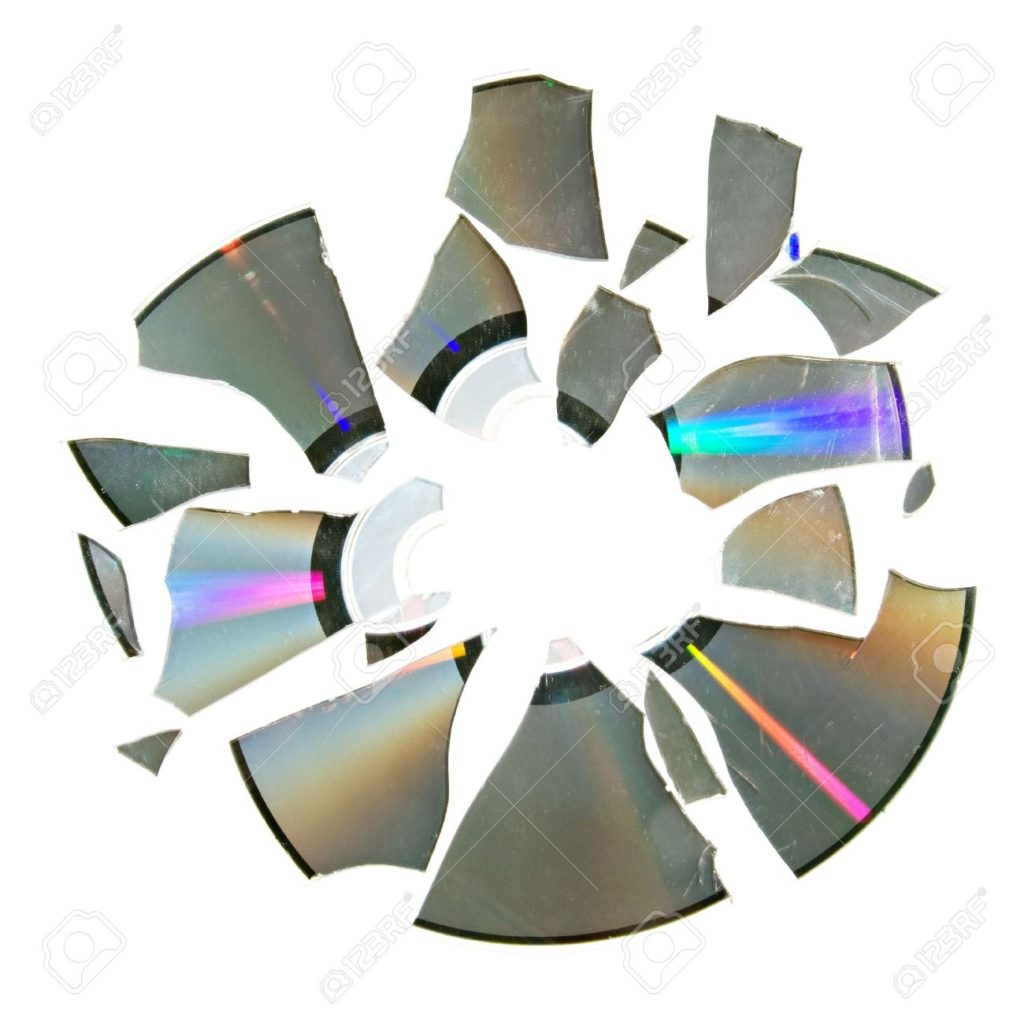With the amount of stories about vinyl records doing the rounds in recent years you’d be forgiven for thinking that no one cares about the humble Compact Disc, surely there must be some mistake!? With the first CD released way back in 1982 (Claudio Arrau performing Chopin waltzes fact fans), they’ve now been a part of our lives for 30 plus years, so it stands to reason that there is a huge number of people out there with extensive CD collections – this short article aims to give you a brief guide on how to care for the collection, how to best store it and some clues as to what to look out for in terms of collect-ability.
How Are CDs Made?
1. First a thick, soft, clear plastic layer. This layer comprises the majority of the CD’s thickness and weight. It serves two purposes. First, it protects the data layer from damage on the play side and Secondly it acts as a lens to focus the CD player’s laser onto the data layer so it can more easily read the data (much the way lenses in spectacles help eyes focus on the words on a page).
2. Next the data layer is where the music and any other information are stored. It’s the layer that the CD player “reads” in order to create the music, graphics, etc. The data layer is molded or pressed into the top of the clear plastic layer. The data in the data layer is arranged in tracks that spiral like the grooves on a vinyl record (except CDs are read from the “inside out”, the opposite of vinyl records).
3. Now a reflective, metallic layer is located on top of the data layer. It allows the disc to function like a mirror, reflecting the CD player’s laser back to the detector in the CD player after it reads the data layer It’s this layer that gives the CD’s play side a shiny appearance.
4. A thin, hard protective layer is an ultra-thin plastic coating that is added to provide some protection for the reflective and data layers, while also forming a surface upon which the label information can be printed.
5. Finally the label layer is printed on top of the protective layer. It contains the title, graphics, band and other information to identify the contents of the disc. (label side).
How Does It Work? How Does A CD Play?
If you could stretch out into a straight line all the data stored on a single compact disc it would be over 4 miles long!
1. All Compact discs and other optical disc players read from the inside o.f the CD out, just the opposite of a vinyl record. The inner 3/4 inch radius region is for “clamping”, followed by a thin text band used to usually identify the manufacturer. These regions do not contain data and are not affected by scratching or other damage.
2. In a music CD, the first, inner band of data, called the “lead-in”, contains the table of contents for the CD. It tells the CD player how to navigate around the disc (where to find the various musical tracks, etc). Scratches or other surface damage in this area can leave the cd completely unplayable. The song tracks begin just outside the lead-in. The longer the song, the greater the area/width of data in the track. Damage to a disc in an area of data outside the lead-in usually affects only the music that is contained in that area, although with more severe damage the CD player can sometimes “lock up” (or jump) on the damaged area so it can’t get to the later tracks.
3. A full CD holds a maximum of 74 minutes of music. When a disc isn’t full the outer portion of the CD appears blank. Damage in the blank region has no effect on the playability of the CD. You can usually identify the lead-in and blank regions because they reflect light a little bit differently, particularly when viewed at an angle and under good light. Although it is difficult to see the individual tracks, they can sometimes be identified by the very thin faint circles that separate them.
4. Unlike a vinyl record, which is read by a needle which lies within the grooves, a CD is read by a laser which allows it to be read with only the laser beam “touching” the data. The laser beam enters the CD on the play side, travels through the CD’s clear plastic layer, picks up information from the data layer, then bounces off the reflective coating on the back side of the data layer. The reflected laser beam then travels back through the clear plastic layer, out of the CD, and into the CD player’s “detector”. The detector then helps the CD player convert the information carried by the laser into sound
Caring For Your CD Collection
For a majority of the time a compact disc offers a “deterioration free” method of playing music, since it is based on “optical” transference of information (laser) against mechanical” transference (needle or tape head). For this reason, playing your CD imposes no wear and tear on the disc, unlike both vinyl records and audio cassettes which suffer continual wear from friction caused by their mechanical processes. This does not mean that your CDs are indestructable but nearly all the wear and tear on a CD can be prevented by careful handling.
Following are guidelines for proper disc handling:
1. Always handle the disc by its edge or center hole.
2. On no account scratch the CD on the label or play side. A scratch that penetrates the label side will directly destroy a considerable amount of data, surprisingly a scratch on the play side of the disc is often invisible to the CD player and if not can sometimes be repaired.
3. Refrain from sticking paper or tape on the label surface. While it won’t hurt the disc, it could interfere with the CD player.
4. Do not write on the label surface with a ballpoint pen or other hard object. This will almost certainly damage the data layer. Also the solvent in a marking pen; could penetrate the label and deteriorate the reflective layer (which would damage the disc beyond repair).
5. Do not expose a CD to high temperature or humidity for an extended period of time, high temperatures can warp the disc and cause deterioration of the reflective layer.
6. Do not allow CDs to remain out of their cases for long periods of time and handle only when placing them into and removing them from the CD player
7. Take extra care with CDs when using them outside. Sand or dirt can cause damage to the label side (which can’t be repaired).
8. Keep your CDs clean by gently wiping both the label and play side surfaces with a non-abrasive (i.e. soft cotton) cloth prior to and after each use.
Storing Your CDs
Although CDs can tolerate a fairly wide range of conditions without immediate damage, it is best to store CDs in cool and moderately dry environments. Slight temperature and humidity changes ordinarily do no harm. Fast changes between very warm and wet conditions to cooler and very dry conditions can sometimes result in warping and distortion.
The plastic “jewel cases” provided by many manufacturers and distributors give good protection against scratches, dust, light, and rapid humidity changes. Protect your cased CDs further by storing them in a closed box, drawer, or cabinet. This gives additional protection from light, dust, and climate fluctuations. After using or cleaning your disc, always return it to its case.
Other storage devices, such as zippered cases and sleeve-style holders, provide less but usually adequate protection against damage. Since they can make it easier to keep CDs handy and organized, such storage cases are often worth the moderate increase in risk of damage. When using these cases, be careful to keep them free of dust and debris and, if you retain the literature that comes with the CD, avoid rubbing the play side of the CD across it.
Nearly all damage to CDs occurs when the disc is outside the case and the CD player. Generally, you won’t have any problems if the CD is handled correctly and carefully returned to its stored location after use.
Are CDs collectable?
It’s a question we are often asked here at eil Towers, and, as with vinyl records, there is no easy answer. As a guide most popular chart CDs (those which sell the most) tend to be kept in print by the labels and do not (at this point in time) rise in value. Needless to say if you’re particular music bag is more specialist than major label chart fodder then your collection of Ethiopian jazz or Cambodian psych compilations may well rise in value. Similarly, import CDs can be more desirable as these not only offer the mystique of a foreign pressed CD they can also feature different artwork, include different tracklistings or include bonus content.
Moreover, many CDs are initially released in limited edition digi-pack sleeves or they may includes a bonus disc not included on subsequent pressings, these types of releases are worth looking out for. Also, some artists change labels, for example, David Bowie, his first CD releases were on RCA (his original label from the ’70s), these were largely no frills editions and released in the early days of compact discs, shortly after Bowie left the label and the RCA issues were withdrawn making these versions quite collectable to the Bowie completist.
If all that’s got you a little CD hungry be sure to check eil.com for our extrensive range of CD collectables, we’ve got imports, limited editions, long deleted CD singles, withdrawn CDs, promos and more, to see more click here
eil.com – the world’s best online store for rare, collectable and out of print Vinyl Records, CDs & Music memorabilia since 1987





Great article. We really liked the guidelines for handling and storage.
Let me add that CDs can be quite collectable, judging by the top prices paid every day for rare CDs at popular auction sites.
A few examples:
– over 1500$ for a sealed Fleetwood Mac CD in longbox
– over 1700$ for a first pressing Banksy Paris Hilton CD
– 1500$ for a Prince Piano & Microphone Gala 2CD set
– 1400$ for a Michael Jackson Signature Series CD
and the list goes on…
You may know about sites that collect auction sales history for vinyl, but you may not heard such a site exists for the “less popular” formats: CD, Cassettes, Reel-to-reel tapes and all the rest: CollectableCDs.com. Give it a spin!
Thanks for reading and the heads up – will take a look.